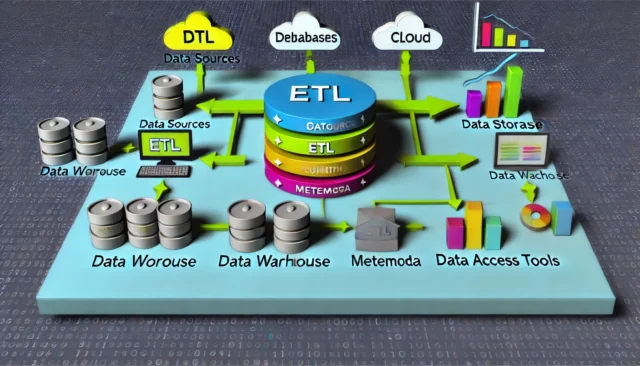An effective data warehouse architecture cannot be underestimated at a time of big data volume and complexity. Data analysts and enterprise solution architects working for multimillion-dollar enterprises depend heavily on understanding which components make up an efficient data warehouse architecture so as to use information efficiently. This blog post will give insight into this topical discussion while equipping you with the information to facilitate better organizational processes and decision-making abilities.
From data modeling to integration, this post will cover all the essentials necessary for success in your role. Each section offers tailored information designed specifically to provide actionable insights that can be implemented within an enterprise.
Understanding Data Warehousing Essentials
You may be wondering, what is a data warehouse? Well, at its core, a data warehouse serves as a centralized repository where information from various sources is combined, stored, analyzed, and reported on. Unlike traditional databases, which tend to prioritize transaction processing over read access and analytics processing capabilities, data warehouses offer faster access to large datasets, which assists decision-making for enterprise operations.
Data warehouses are designed to facilitate business intelligence activities like reporting and analysis that enable informed decisions. However, when used by large enterprises, their scalability and performance become paramount as they must deal with massive volumes of data while simultaneously supporting complex queries. Therefore, their architecture must adapt accordingly.
Understanding data warehousing requires understanding its three essential components (data sources, storage systems, and presentation layers) that comprise its architecture. Each plays an essential part in helping organizations leverage insight from their data warehouse.
Key Components of Data Warehouse Architecture
A data warehouse architecture begins with data sources, which vary based on an enterprise. They might include operational databases, external feeds, third-party apps, flat files, or spreadsheets. This is because many complex environments demand seamless integration among various data sources.
Integrating data from multiple sources requires efficient ETL (Extract, Transform, and Load) processes. Extraction involves collecting the data from various source systems. Transformation includes cleaning it up into an appropriate format for storage. Finally, loading refers to placing transformed data in a data warehouse.
Data sources often comprise both structured and unstructured information. Structured information typically resides in relational databases, while unstructured content such as documents, emails, and multimedia can include files. Efficiently navigating both types of data is key for businesses seeking comprehensive insight and a holistic view of their operations.
Once data has been extracted and transformed, it must be stored within a data warehouse. There are two primary options for storage architectures (traditional data warehouses and cloud-based platforms) that may be utilized. Traditional warehouses typically involve significant upfront investments, while cloud-based platforms provide greater scalability and flexibility, allowing organizations to store information without physical infrastructure restrictions.
Data modeling is an indispensable part of data storage. A properly structured model allows for swift retrieval and provides an organizing framework in the warehouse. Popular modeling techniques include star schema, snowflake schema, and galaxy schema, which each serve specific analytical needs. Large enterprises must adopt suitable data models to ensure optimal performance and user access.
Storage layers must also accommodate various storage formats, including columnar storage that speeds query processing and improves analytic operations. Enterprises should carefully consider all their options when choosing their preferred format to optimize overall data warehouse performance.
Data warehouse architecture features an important data presentation layer that allows data to be delivered directly to end-users through reporting and analytics tools, with data visualization taking place as part of this layer to engage end-users in meaningful ways and garner useful insights from it.
Business intelligence (BI) tools play a pivotal role in this process, enabling users to build dashboards, reports, and visualizations that help visualize complex datasets for analysis. Useful BI tools transform raw data into actionable insights that support informed decision-making across enterprises, particularly large ones where being able to present user-friendly information drives effective decision-making across levels.
Roles and Responsibilities in Data Governance
Effective data governance is integral for upholding the integrity and reliability of data warehouses, including creating policies and procedures to manage data, complying with regulations, and setting quality standards. Large enterprises must take particular care with data governance due to the large volume and complexity of information being processed.
Governance frameworks should encompass essential elements of data stewardship, lineage tracking and metadata management. Data stewards are accountable for overseeing data quality and adhering to governance policies. Data lineage refers to tracking the flow of data throughout its lifecycle to ensure transparency and accountability. While metadata management ensures users understand its context, source and relevance.


















